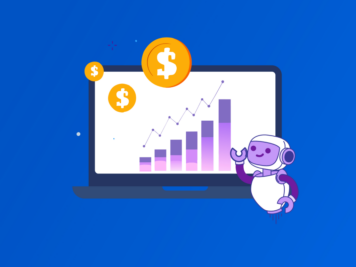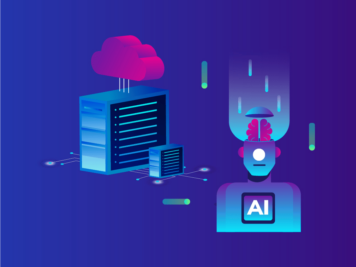AI trends in banking are rapidly reshaping the financial landscape. Generative AI (GenAI) leads these innovations, unlocking new perspectives and advancements. Citi Bank projects that AI implementation could increase the banking industry’s overall profits by $170 billion, a 9% boost, by 2028.
But how exactly AI is disrupting the way we bank? Here’s the gist: AI is automating complex tasks, reducing operational costs and increasing efficiency. AI-based predictive analytics helps banks make better decisions and offer personalized financial products that fit your specific needs. Additionally, AI helps detect fraud and manage risks, ensuring the safety of your money.
Early adopters have already won the first round. According to recent reports from Forbes, Accenture and S&P Global, banks that adopted AI early are already enjoying the benefits, including greater efficiency and a strategic advantage over competitors. Others are also catching up. Gartner expects that by 2026, more than 80% of banks will use GenAI, up from 5% today. This huge growth demonstrates how disruptive GenAI can be in banking.
We have identified the top 10 AI trends in banking with the potential to influence the industry in 2024. Along with the trends, we will also explore in this article how these advancements are creating new opportunities, improving security, and shaping the future of banking.
Top 10 AI trends in banking in 2024
1. Operating models for generative AI in banking.
The first trend on our list is the increasing use of centralized operating models for GenAI in banks.
A shift from decentralized data practice to a centralized operating model is taking root in banks. According to a recent survey by McKinsey & Company, more than half of companies, including technology giants with approximately $26 trillion in assets, have adopted a more centralized organization for generative AI.
But why is this shift happening?
GenAI presents a different set of challenges that a centralized approach can better address. These challenges include:
- Generation of inaccurate or illogical information.
- Violation of intellectual property rights
- Difficulty in understanding how the system works.
- Possible biases and unfairness in the results.
- Security vulnerabilities
Centralized monitoring ensures that pilot programs lay the foundation for larger-scale deployment and allows for more effective allocation of resources from scarce GenAI expertise. This collaborative environment promotes a sense of teamwork while attracting and retaining talent.
The idea is to strike the right balance. The ideal approach takes into account each bank’s unique structure and culture while ensuring scalability. A well-designed centralized model can ensure an effective implementation of GenAI and lay the foundation for an AI-driven future in banking.
2. Increased productivity in banking sector through GenAI
The second trend on our list dives into one of the most exciting advancements in banking for 2024: the rise of Generative AI (GenAI).
McKinsey Global Institute estimates GenAI could inject a staggering $200 billion to $340 billion annually into the banking sector alone, representing a significant boost to operating profits. This translates to a potential revenue increase of 2.8 to 4.7 percent!
Here’s why GenAI is so exciting for banks: it can process massive amounts of text data. This is a goldmine for banks that deal heavily with regulations and customer interactions.
Imagine virtual assistants that can instantly access product guides and policies, allowing service professionals to address customer inquiries with ease. Chatbots powered by GenAI can analyze questions and route them to the most qualified staff member, saving everyone valuable time.
For employees, GenAI can empower them with readily available resources and streamline tasks through AI-powered content creation and code generation.
What’s even more exciting is that GenAI’s potential extends beyond just productivity. As the technology matures, it could reshape job functions, leading to a more optimized workforce.
3. AI enabled autonomic systems in banking
Autonomic systems are revolutionizing the banking sector with their ability to self-manage and adapt.
These intelligent systems, powered by AI, learn from their environments and adjust algorithms in real-time to optimize performance within complex financial ecosystems. Essentially, they create an agile set of technological tools that can handle new situations, optimize efficiency, and even defend against cyberattacks – all without human intervention.
This goes way beyond simple robo-advisors. We are talking about advanced systems that can transform how banks operate. Gartner, even named autonomic systems a key trend in banking for the next few years.
But why are banks so excited? Because Autonomic systems have the potential to: Reduce risks, cut costs and grow revenue.
For these reasons, it’s a critical trend to watch in the banking sector for 2024 and beyond. They promise a future where banks are more efficient, secure, and profitable.
4. AI for security and fraud migration
Businesses are investing heavily in AI for security and fraud mitigation domain.
Fraud is a persistent drain on the financial sector, with global losses estimated at a staggering $485.6 billion in 2023 (source: [Nasdaq’s 2024 Global Financial Crime Report]). This is why banks are rapidly adopting AI to combat security threats and fraud.
A recent ISG study underscores this trend, revealing that a staggering 92% of respondents in the banking industry are either planning to use or are already using AI, with security and fraud mitigation as the primary focus. This highlights the critical role AI plays in safeguarding financial institutions and their customers.
However, fraudsters constantly adapt. Traditional security measures often struggle to keep up with new tricks like synthetic identity fraud.
To stay ahead, banks are increasingly turning to generative AI. This technology analyzes massive amounts of data to identify patterns and red flags linked to fraud, even as fraudsters develop new methods.
Another survey reveals that 34% of organizations are actively using AI-based security tools. These tools go beyond analyzing past data – they can learn and adapt over time, becoming more effective at spotting novel fraudulent activities.
The survey also found significant adoption of complementary technologies. Here’s a closer look:
- 26% are using or implementing privacy-enhancing technologies (PETs)
- 25% are pursuing ModelOps (aka AI model operationalization)
- 24% are focusing on model monitoring
The rise of AI, PETs, ModelOps, and model monitoring demonstrates the banking industry’s commitment to building a more secure financial environment. AI is no longer just a trend in fraud prevention – it’s a necessity.
5. LLM’s in banking
The banking sector is currently undergoing a digital metamorphosis, and at the heart of this transformation lies a powerful technology: Large Language Models (LLMs).
These AI models are more than just a tech upgrade; they’re poised to fundamentally change how banks operate and connect with customers.
LLMs have the potential to deliver a personalized customer journey. By crunching massive amounts of data in real-time, they can provide insightful and natural-sounding responses to customer inquiries. This personalization is becoming increasingly important as more and more people switch to digital banking.
As of 2022, a staggering 78% of adults in the U.S. expressed a preference for banking via a mobile app or website. This highlights that the rise of LLMs is not an isolated trend; it’s part of a larger digital shift in the banking industry. A survey conducted across 390 financial institutions in 28 states revealed a clear trajectory towards more digital and AI-based solutions in 2024.
The digital shift is happening against a backdrop of greater stability in the U.S. banking industry, following bank failures in March and April 2023.
With most banks expected to perform well and build capital in 2024, the stage is set for LLMs to bring about significant changes in the banking industry.
6. AI in pricing
Optimizing pricing has always been a top priority for banks, directly impacting on their bottom line. However, 2024 marks a shift from mere optimization to personalization. Banks are now combining human expertise with generative AI and rich data sets to fuel powerful scenario planning and personalized pricing strategies.
This isn’t just about technology; it’s about a data-driven approach to pricing decisions. Here’s what’s driving this trend:
Soaring AI Investment: The financial sector’s AI spending reached an estimated $35 billion in 2023 and is projected to hit $97 billion by 2027 with a 29% compound annual growth rate (CAGR). (Source: Financial sector AI spending worldwide 2023 – Statista)
Fintech AI Market Growth: The market size of AI in fintech grew from 42.83 billion U.S. dollars in 2023 to 44.08 billion U.S. dollars in 2024, indicating the growing investment in this area. (Source: Market size of AI in fintech 2023-2024 – Statista)
Beyond just these stats, banks see the clear benefits of optimized pricing.
In fact, the banking industry invested heavily in foundation models (the building blocks of AI) in 2023, accounting for a massive 72% of all new models created (Source: AI Index: State of AI – Stanford University).
The message is clear: AI is revolutionizing how banks set prices. By leveraging AI and data, banks can move beyond static rates and create personalized pricing models for each customer. This shift has the potential to unlock significant revenue and profitability gains, solidifying AI as a critical component in the future of bank pricing strategies.
7. Code assistant for digital transformation
According to the report by Gartner, by 2028, a staggering 75% of enterprise software engineers are expected to utilize AI code assistants, compared to a mere 10% in early 2023.
This surge is driven by Generative AI, a powerful technology that can analyze information and create entirely new code. It’s acting as the fuel for this transformation.
Furthermore, a significant 63% of organizations are already actively piloting, deploying, or reaping the benefits of AI code assistants [Source: Gartner, April 11, 2024, Press Release]. This widespread adoption underscores the increasing recognition of the transformative power of these AI tools.
The market is booming too, expected to reach a value of $12.6 billion by 2028. [Source: Yahoo Finance, November 21, 2023]. The hike in adoption isn’t a coincidence. Banks are realizing the efficiency gains and innovation potential of AI code assistants.
Looking ahead, Gartner predicts that 60% of data used for AI will be synthetically generated by 2024. [Source: Gartner].
This “artificial data” plays a crucial role – it allows AI to better replicate real-world scenarios, envision future possibilities, and ultimately, mitigate risks associated with AI implementation.
As AI code assistants become more sophisticated and widely adopted, we can expect them to revolutionize the way banks operate. The future holds the promise of a more efficient, innovative, and ultimately, a more customer-centric banking experience for everyone.
8: Enhanced AI support for customers
The eighth trend on our list focuses on enhanced AI support for customers.
The transition of financial institutions from a product-focused to a customer-focused business is a significant trend in 2024. This shift has amplified the need for rapid, accurate, and personalized responses to customer queries.
The good news? Customers are on board! 73% of consumers believe AI can have a positive impact on their customer experience.
Building on this, Generative AI is emerging as a powerful tool to meet these evolving needs. These AI models (LLMs) can create hyper-personalized customer interfaces that deliver empathetic and timely responses. They can be used to create personal digital assistants capable of summarizing contracts, answering questions, and offering a range of interface options, including text, audio, and imagery.
The impact of AI extends beyond theory. 80% of customers who interacted with AI for customer service reported a positive experience. This translates to happier customers, potentially reflected in a higher Net Promoter Score (NPS), a key metric for customer loyalty.
But the benefits go beyond happy customers:
Streamlined operations powered by AI mean lower costs for banks. The AI market in banking is expected to reach a massive $407 billion by 2027, and 68% of support teams already see AI influencing customer expectations. (Source: Customer Service Trends Report 2024).
With AI handling routine tasks, human staff can focus on more complex issues. In fact, 64% of businesses believe AI will significantly increase their overall productivity. (Source: Forbes Advisor survey 2024).
The trend of enhanced AI support for customers is set to redefine the banking sector. It promises a more personalized, efficient, and satisfying customer experience.
9. VR-Enabled retail banking centers
The future of retail banking is immersive and personalized. VR-enabled retail banking centers represent a revolutionary merger of physical and virtual worlds. This isn’t just about VR headsets; it uses Generative AI to craft a unique experience.
Imagine a virtual banking representative tailored specifically to you. Equipped with conversational AI and access to your financial data, this AI agent can answer your questions naturally, guide you through complex transactions, and explain products in an engaging way.
But it’s not just about technology; transparency is paramount. VR centers ensure the customers are aware of that they are interacting with AI, fostering trust in the system.
The VR market is flourishing, a report by IDC suggests that VR headset shipments are forecast to reach 24.7 million units by the end of 2028 with projected headset shipments expected to reach 43.5 million by 2025, positioning VR as a game-changer in redefining banking customer service.
Customers can visualize a mortgage on a virtual property tour or explore investments in a simulated 3D environment, making banking more engaging and interactive.
The real-world benefits of VR-enabled centers are significant.
The VR hardware and software market is expected to reach $244.84 billion by 2032 from $32.64 billion in 2024 (Fortune Business Insights). Furthermore, the banking sector is leading the way in VR/AR spending, with the highest growth rate between 2020 and 2024 (126.7% CAGR).
VR-enabled retail banking centers offer a more personalized, immersive, and efficient service delivery model, promising to redefine the banking experience in 2024 and beyond.
10. Getting to know your customer with AI
All the top AI trends in banking for 2024 are going to impact customer onboarding significantly.
Traditionally, customer onboarding process has been time-consuming due to the need to comply with Know Your Customer (KYC) standards, which require detailed customer reports. This has been a task involving high human involvement and significant time and resources.
However, the advent of Generative AI, in conjunction with other machine learning models, has revolutionized this process. These technologies can conduct preliminary data searches and analysis, accelerating the KYC process. They can also summarize and filter existing search engine results, providing valuable customer information for informed decision-making.
This is not a small feat, considering that over 40% of financial institutions used generative AI in 2023, with more ongoing explorations among industry leaders.
The growing adoption of AI in banking underscores its potential. The global generative AI market in finance is expected to reach a staggering $9.48 billion by 2032, reflecting a compound annual growth rate of 28.1%.
This trend is further solidified by the fact that 75% of large banks were projected to deploy AI-driven revenue-generating projects by 2023.
“Getting to Know Your Customer with AI” is a transformative trend, paving the way for a faster, smarter, and more efficient customer onboarding experience.
Wrapping Up: A Look back at the Top 10 AI Trends in banking for 2024
Our exploration of the top 10 AI trends in banking for 2024 revealed diverse applications, from optimizing operating models to AI-powered customer onboarding.
These trends all point towards a common future: AI is poised to revolutionize the banking sector by streamlining processes, reducing costs, and unlocking new avenues for value creation.
In essence, AI is not just transforming banking – it’s redefining it. As we move forward, one thing is certain: Generative AI will continue to be a driving force in the industry. The trends we’ve discussed are just the tip of the iceberg, and we can expect to see more groundbreaking developments in the years to come.
Frequently Asked Questions (FAQs)
How will AI improve customer service?
Generative AI can create personalized customer interfaces with AI assistants that can answer questions, summarize complex documents, and even offer a variety of interface options (text, audio, or imagery). This can lead to faster response times, more accurate information, and a more engaging experience.
How can I benefit from AI in banking?
AI can offer a faster and more convenient banking experience. You can expect quicker loan approvals, personalized financial advice, and 24/7 customer support through AI chatbots.
What are the challenges of implementing AI in banking?
The biggest challenges include ensuring data privacy and security, overcoming the initial investment costs, and adapting to a changing regulatory landscape. However, selecting a reputable AI solutions provider with experience in the financial sector is crucial. Look for a company with a proven track record of successful AI implementations in banking.









